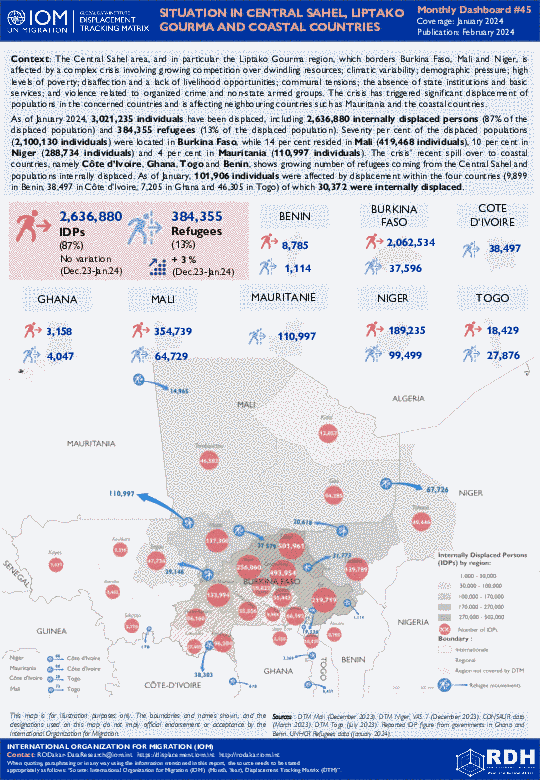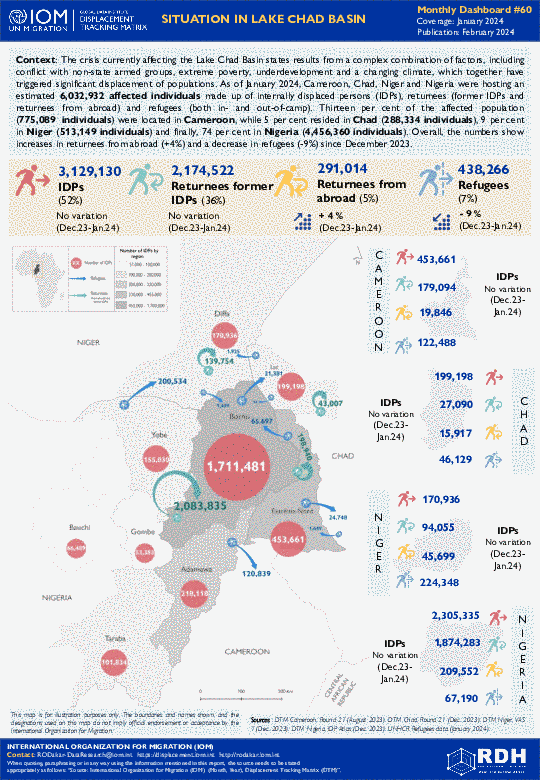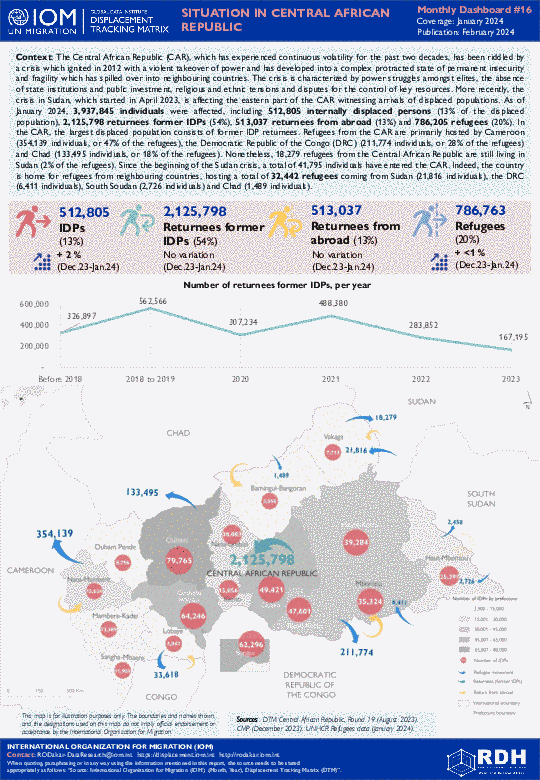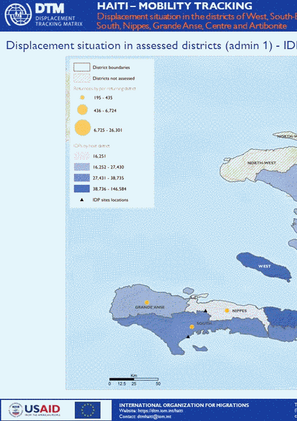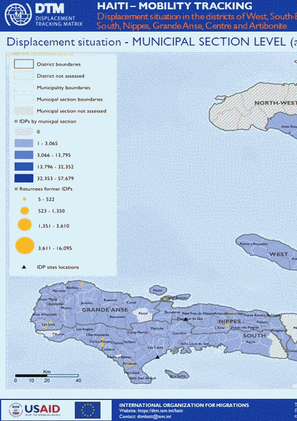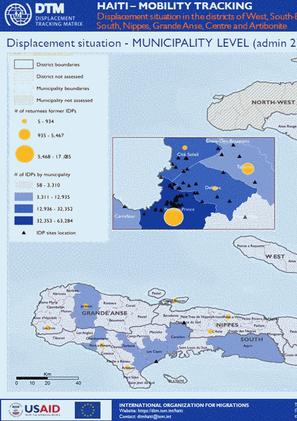-
Countries
-
Data and Analysis
-
Special Focus
-
Crisis Responses

Contact
dtmhaiti@iom.int
Language
English
Location
Haiti
Period Covered
Feb 07 2024
Feb 13 2024
Activity
- Mobility Tracking
- Event Tracking
This information was collected following various armed attacks that occurred in several neighborhoods of the capital since 5 February, in the municipalities of Carrefour, Cité Soleil and Tabarre. This report is an update of the one published on 11 February and other updates will be published depending on the evolution of displacement. A total of 9,901 people have been displaced following these attacks, including 7,261 following attacks in neighborhoods bordering the municipalities of Cité Soleil and Tabarre as well as 2,640 following those in the municipality of Carrefour. Most of these people (90%) took refuge in areas located in the West district and the rest left for provinces, notably towards Nippes (5%) and Center (3%). The majority (63%) took refuge with host families and 37% in 13 sites (all located in the Port-au-Prince Metropolitan Area, in the West district), including 3 sites which already existed before these incidents and 10 newly created

Contact
DTMThailand@iom.int
Language
English
Location
Thailand
Period Covered
Oct 09 2023
Jan 24 2024
Activity
- Survey
- Site Assessment
This factsheet aims to provide a snapshot of multi-sectoral conditions, needs, and challenges among Myanmar migrants in Chiang Mai province as captured between October 2023 and January 2024 by IOM Thailand’s multi-sectoral assessment of needs. The purpose of this assessment is to provide insights regarding the severity of needs among migrant populations, identify vulnerable population groups and geographic areas with the most acute needs, inform assistance planning and relevant Sustainable Development Goals (SDGs) targets, and provide sectoral and inter-sectoral baselines for future assessments.
The Central Sahel area, and in particular the Liptako Gourma region, which borders Burkina Faso, Mali and Niger, is affected by a complex crisis involving growing competition over dwindling resources; climatic variability; demographic pressure; high levels of poverty; disaffection and a lack of livelihood opportunities; communal tensions; the absence of state institutions and basic services; and violence related to organized crime and non-state armed groups. The crisis has triggered significant displacement of populations in the concerned countries and is affecting neighbouring countries such as Mauritania and the coastal countries.
As of January 2024, 3,021,235 individuals have been displaced, including 2,636,880 internally displaced persons (87% of the displaced population) and 384,355 refugees (13% of the displaced population). Seventy per cent of the displaced populations (2,100,130 individuals) were located in Burkina Faso, while 14 per cent resided in Mali (419,468 individuals), 10 per cent in Niger (288,734 individuals) and 4 per cent in Mauritania (110,997 individuals). The crisis’ recent spill over to coastal countries, namely Côte d’Ivoire, Ghana, Togo and Benin, shows growing number of refugees coming from the Central Sahel and populations internally displaced. As of January, 101,906 individuals were affected by displacement within the four countries (9,899 in Benin, 38,497 in Côte d’Ivoire, 7,205 in Ghana and 46,305 in Togo) of which 30,372 were internally displaced.
The crisis currently affecting the Lake Chad Basin states results from a complex combination of factors, including conflict with non-state armed groups, extreme poverty, underdevelopment and a changing climate, which together have triggered significant displacement of populations.
As of January 2024, Cameroon, Chad, Niger and Nigeria were hosting an estimated 6,032,932 affected individuals made up of internally displaced persons (IDPs), returnees (former IDPs and returnees from abroad) and refugees (both in- and out-of-camp). Thirteen per cent of the affected population (775,089 individuals) were located in Cameroon, while 5 per cent resided in Chad (288,334 individuals), 9 per cent in Niger (513,149 individuals) and finally, 74 per cent in Nigeria (4,456,360 individuals). Overall, the numbers show increases in returnees from abroad (+4%) and a decrease in refugees (-9%) since December 2023.
The Central African Republic (CAR), which has experienced continuous volatility for the past two decades, has been riddled by a crisis which ignited in 2012 with a violent takeover of power and has developed into a complex protracted state of permanent insecurity and fragility which has spilled over into neighbouring countries. The crisis is characterized by power struggles amongst elites, the absence of state institutions and public investment, religious and ethnic tensions and disputes for the control of key resources. More recently, the crisis in Sudan, which started in April 2023, is affecting the eastern part of the CAR witnessing arrivals of displaced populations.
As of January 2024, 3,937,845 individuals were affected, including 512,805 internally displaced persons (13% of the displaced population), 2,125,798 returnees former IDPs (54%), 513,037 returnees from abroad (13%) and 786,205 refugees (20%). In the CAR, the largest displaced population consists of former IDP returnees. Refugees from the CAR are primarily hosted by Cameroon (354,139 individuals, or 47% of the refugees), the Democratic Republic of the Congo (DRC) (211,774 individuals, or 28% of the refugees) and Chad (133,495 individuals, or 18% of the refugees). Nonetheless, 18,279 refugees from the Central African Republic are still living in Sudan (2% of the refugees). Since the beginning of the Sudan crisis, a total of 41,795 individuals have entered the CAR. Indeed, the country is home for refugees from neighbouring countries, hosting a total of 32,442 refugees coming from Sudan (21,816 individuals), the DRC (6,411 individuals), South Soudan (2,726 individuals) and Chad (1,489 individuals).
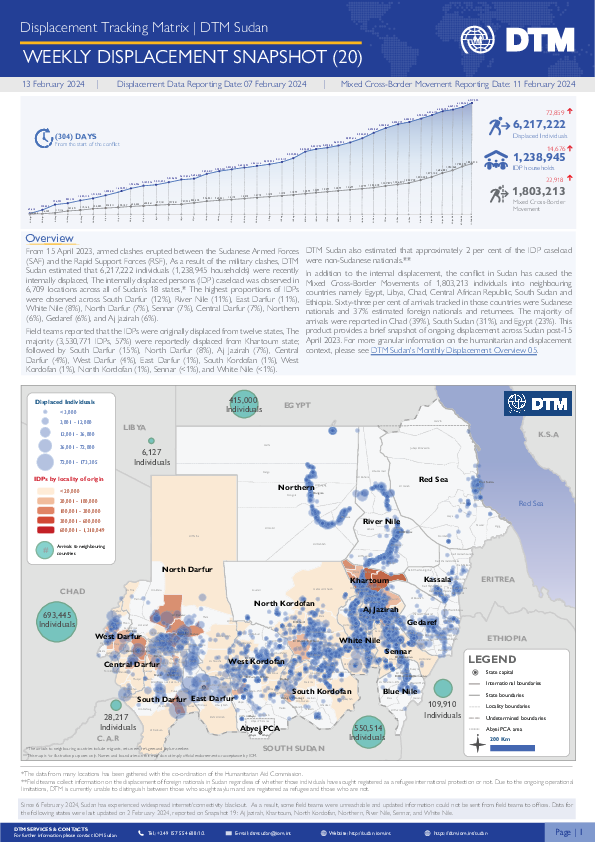
Contact
DTM Sudan; dtmsudan@iom.int
Language
English
Location
Sudan
Period Covered
Feb 03 2024
Feb 07 2024
Activity
- Mobility Tracking
- Baseline Assessment
Overview
From 15 April 2023, armed clashes erupted between the Sudanese Armed Forces (SAF) and the Rapid Support Forces (RSF) in multiple cities across Sudan. Clashes initially took place in cities across Northern and Khartoum states, later spreading across the Darfur and Kordofan regions.
Highlights
- DTM Sudan estimates that 6,217,222 individuals (1,238,945 households) were recently internally displaced.
- The IDP caseload was observed in 6,709 locations across all of Sudan’s 18 states.
- The highest proportions of IDPs were observed across South Darfur (12%), River Nile (11%), East Darfur (11%), White Nile (8%), North Darfur (7%), Sennar (7%), Central Darfur (7%), Northern (6%), Gedaref (6%), and Aj Jazirah (6%).
- Field teams reported that the IDPs observed were originally displaced from twelve states. The majority (3,530,771 IDPs, 57%) were reportedly displaced from Khartoum state; followed by South Darfur (15%), North Darfur (8%), Aj Jazirah (7%), Central Darfur (4%), West Darfur (4%), East Darfur (1%), South Kordofan (1%), West Kordofan (1%), North Kordofan (1%), Sennar (<1%), and White Nile (<1%).
- IOM-DTM also reported that an estimated 1,803,213 mixed cross-border movements were made into neighbouring countries.
- This product provides brief insights into those displaced in Sudan post-15 April 2023. For more granular information on the IDP caseload and the displacement context, please see IOM-DTM's Monthly Displacement Overview (05).
DISCLAIMER: Since 6 February 2024, Sudan has experienced widespread internet/connectivity blackout. As a result, some field teams were unreachable and updated information could not be sent from field teams to offices. Data for the following states were last updated on 2 February 2024, reported on Weekly Displacement Snapshot 19: Aj Jazirah, Khartoum, North Kordofan, Northern, River Nile, Sennar, and White Nile.
Between 22 December to 12 February, a series of sporadic attacks and fear of attacks by Non-state Armed Groups in Macomia, Mecufi, Mocimboa da Praia, and Muidumbe triggered the cumulative displacement 10,849 individuals/1,478 families.
Although included within this cumulative displacement estimate- the current Movement Alert #96 reports on recent attacks recorded in Macomia, Chiure and Mecufi between 8 to 12 February that displaced 812 individuals. Within this reporting period, arrivals of displaced families have been mapped across villages of Macomia, Chiure, Metuge, Montepuez, Mecufi, Erati and Ibo.Of the total individuals displaced between 8-12 February, 47 families with 139 individuals have taken refuge in displacement centers of Macomia (Nanga A and Nanga B), 35 families with 108 individuals have taken refuge in displacement centers of Chiure (Maningane, Muajaja, and Namisir), 10 families with 45 individuals have taken refuge in displacement centers of Montepuez (Ntele), and 2 families with 22 individuals have taken refuge in displacement centers of Metuge (Ngunga).
This map is the result of DTM evaluations conducted in 7 of Haiti's 10 departments. It presents the displacement situation (IDPs and formerly IDP returnees) at the level of districts (admin 1)
This map is the result of DTM evaluations conducted in 7 of Haiti's 10 districts. It presents the displacement situation (IDPs and formerly IDP returnees) at the level of the municipal sections (admin 3)
This map is the result of DTM evaluations conducted in 7 of Haiti's 10 districts. It presents the displacement situation (IDPs and returned formerly IDPs) at the municipal level (admin 2)
